Table of contents
On average, small business owners have 80% of their assets tied up inside their corporations.
The challenge for them is to do the following in a tax-efficient manner:
- Invest the funds
- Withdraw the funds to supplement their retirement
- Transfer the assets to their heirs
This post explains how the corporate insured retirement program can help you achieve all the above.
- Key takeaways:
- Investment income is taxed at a high rate inside a private corporation.
- Passive income also reduces the small business deduction, resulting in higher taxes.
- The corporate insured retirement program uses permanent life insurance to extract funds from your corporation tax-free.
- The strategy provides tax savings, greater retirement savings, a tax-efficient estate transfer, and enhanced estate values.
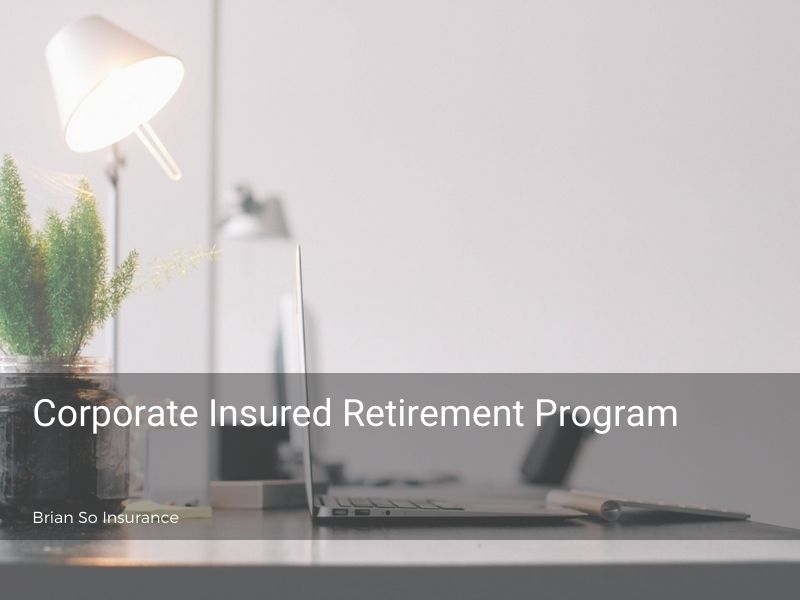
Why You Need A Tax Shelter Inside Your Corporation
Business owners who don’t need all the business’s profits to fund their lifestyles leave the excess in their corporations to invest.
This helps them achieve tax deferral by not paying out a salary or dividend which is taxed at a high personal tax rate (53.5% and 48.89% for the top marginal tax rate in BC for salary and non-eligible dividends, respectively).
Instead, active business income is taxed at either the small business deduction rate (11% in BC up to $500,000) or general corporate tax rate (27% in BC over $500,000).
That’s why business owners often have a significant portion of their savings held within their corporations.
However, these savings produce passive income which attract tax at the highest corporate rate. For interest income earned by BC corporations, this is 50.7%.
A portion of this tax is refundable to the corporation through the RDTOH mechanism when the corporation pays out a dividend to a shareholder.
This is the concept of tax integration, where the taxation of investment income is similar for a shareholder, whether held in the corporation or personally.
But it doesn’t change the fact that without a tax shelter, passive income is taxed annually.
That’s one reason you want a tax shelter in your corporation. The other has to do with new legislation that changed how passive income affects the small business tax rate.
Passive income impact on the small business deduction limit
As mentioned above, active business income up to $500,000 is taxed favourably. $500,000 is the small business deduction (SBD) limit.
However, starting in 2019, the amount of passive income (also known as adjusted annual investment income, or AAII) earned by the company may reduce the SBD.
The reduction is calculated by this formula:
5 x (AAII – $50,000)
For example, ABC company has $75,000 of AAII. Its SBD will be reduced by:
5 x ($75,000 – $50,000) = $125,000
That means its new SBD is:
$500,000 – $125,000 = $375,000
When a company reaches $150,000 of AAII, its SBD is eliminated entirely. Here is a graphic showing the reduction in SBD as AAII increases in BC.
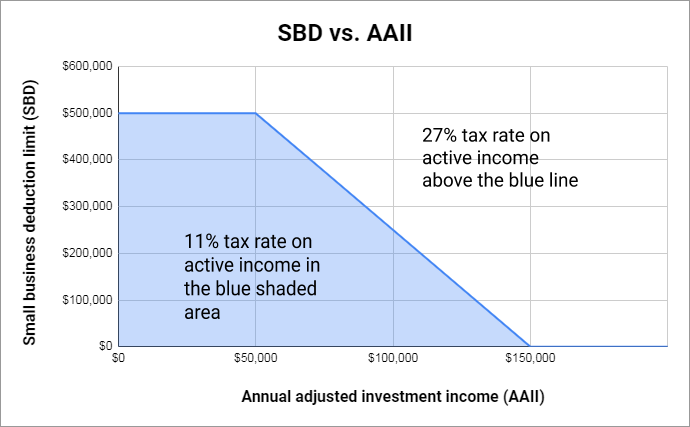
One of the things a corporation can do to reduce the impact of passive income is to use a tax shelter for its passive investments. But without an RRSP or TFSA, how can a corporation shelter its passive investments from tax? That’s where a permanent life insurance policy can help.
How Does The Corporate Insured Retirement Program Work?
The idea is that instead of investing the surplus in your company in passive investments like mutual funds, ETFs, stocks, bonds or real estate, you redirect it into a life insurance policy.
Here, the type of life insurance policy that you need to execute this strategy is a permanent policy that has an investment component.
There are 2 types of permanent policies you can use: participating whole life and universal life. To simplify things, for the rest of this post, I will use the term whole life insurance.
A portion of the funds that you put into the policy pays for the cost of insurance. Anything in excess goes into an investment, which grows tax-sheltered.
With a whole life policy, investment earnings are distributed as dividends back into the policy. The dividends build up the cash value and also increases the death benefit over time.
Before we go look at the step-by-step process, let’s break down the name of the concept into its components to understand it.
Corporate: Obviously, this strategy involves your corporation.
Insured: This gets interesting because many people don’t see the connection between an insurance policy and tax savings. I’ll get into the details on how the insurance works below. The strategy works best if your business has an insurance need. For example, working capital, paying off debts, etc.
Retirement: The main purpose besides saving tax is to build up your retirement nest egg.
Program: You can also call it a concept, plan or strategy.
The 10 steps of the strategy
Step-by-step, this is what the strategy looks like:
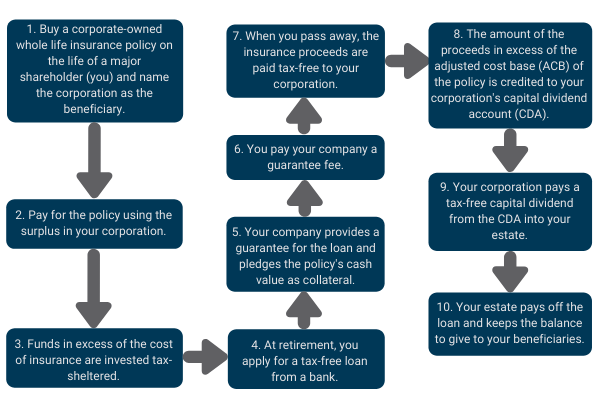
- Insurance terms explained:
- The adjusted cost basis (ACB) is generally the premiums minus the cost of insurance. It typically decreases to zero at your life expectancy, which means the entire death benefit is tax-free.
- The capital dividend account (CDA) is a notional account that allows the corporation to pay a tax-free dividend to its shareholders.
Let’s break down the steps in detail:
1. It’s very important to name the corporation as the beneficiary. If you name yourself, you’ll be assessed a shareholder benefit and will pay personal tax on the premium.
2. Your net profits will likely fluctuate year over year, so you don’t want to put your entire surplus into the policy.
3. This is the advantage of whole life insurance as an investment vehicle. You can deposit extra funds into the policy to accelerate its growth, up to a certain limit.
4. You’ll get a loan through a third party lender, not the insurance company. You also have the option to withdraw the funds directly from the policy or borrowing against it. But both these options may have tax consequences.
5. Your company provides a loan guarantee and assigns the life insurance policy to the bank as collateral for the guarantee.
6. The guarantee fee minimizes the possibility of a shareholder benefit from having your corporation provide the guarantee in step 5. Your corporation has to pay tax on the fee.
7. Because the policy was assigned to the bank in step 5, the executor of your estate will have to provide other collateral for the bank to release the assignment so that the life insurance proceeds are paid to the corporation.
8. It is your accountant’s responsibility to track the balance of the CDA.
9. Tracking the balance is important so that you know how much your corporation can pay as a tax-free capital dividend to your estate. Most or all of the proceeds will be distributed as a capital dividend. Any remaining proceeds can be distributed as a taxable dividend.
10. The executor uses the proceeds to pay off the loan and the estate keeps any remaining amount to distribute to your beneficiaries.
Case Study
Now that you understand the concept, let’s take a look at a scenario where executing the corporate insured retirement program may be beneficial.
In this example, we have a shareholder who is a 45-year-old male non-smoker and owns a consulting firm, ABC Consulting Inc., with 10 employees.
The corporation is running a surplus every year, and can comfortably deposit $10,000 into a whole life insurance policy for the next 20 years.
The policy has an initial death benefit of $314,276.
ABC Consulting Inc. owns the policy and names itself as the beneficiary.
The alternative investment is a balanced portfolio composed of:
- 30% interest earning 2%
- 20% dividend earning 5%
- 20% deferred capital gains earning 6%
- 30% realized capital gains earning 6%
To make a fair comparison, he will invest $10,000 per year into this alternative investment for the next 20 years. The corporate tax rate on passive income is 50.7% and the shareholder marginal tax rate is 49.8% and dividend tax rate is 44.64%.
He’ll retire at 65. With the corporate insured retirement strategy, he will use the cash value inside the policy as collateral for a loan annually that will last until his life expectancy of age 90. The loan interest is 5% and is capitalized and added to the balance of the loan.
With the alternative investment, he will pay out a taxable dividend from the corporation when he retires. The after-tax amount matches the cash flow from the loan.
Let’s compare the results.
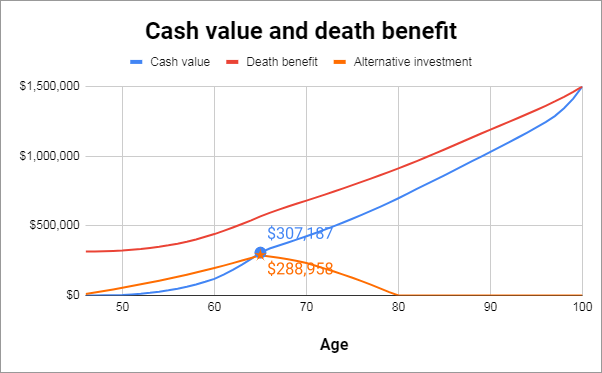
The policy has a death benefit of $314,276 that his business can use if he passes away. The death benefit continues to increase as dividends are earned by the policy.
Based on the cash value of $307,187 at age 65, he can obtain an annual loan of $18,498 until age 90.
The alternative investment grows to $288,958 by age 65. To match the income from the loan, the corporation pays an annual dividend to net $18,498 after tax. But the income stream will only last until age 80.
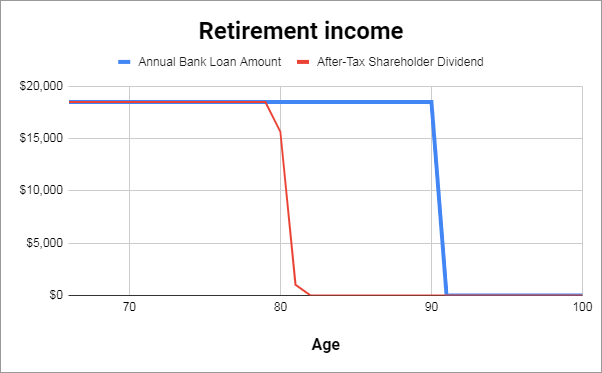
To illustrate the other advantage of using the corporate insured retirement strategy, you have to compare the net estate values.
Using the strategy, the net estate value is the proceeds of the death benefit reduced by the loan that your estate will receive when you pass.
With the alternative investment, the net estate value is the after-tax amount from the dividend paid by the corporation to your estate.
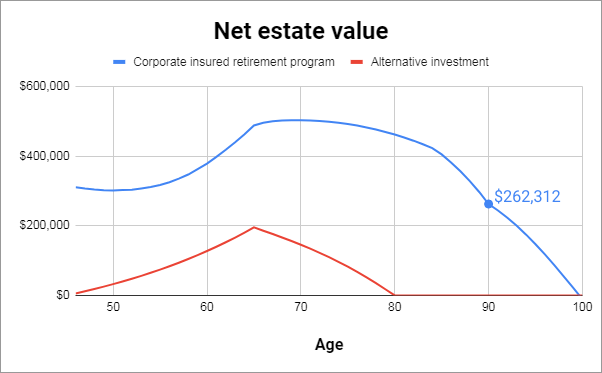
At the life expectancy of age 90, the net estate value using the corporate insured retirement strategy is $262,312, while it has long dropped to $0 with the alternative investment.
Benefits Of The Corporate Insured Retirement Program
As you can see from the case study, there are several benefits of using the corporate insured retirement program.
Tax savings: By redirecting your corporate surplus from passive investments to a whole life insurance policy, your corporation pays less tax today and in the future.
Tax-efficient estate transfer: By redirecting funds to the whole life policy, you reduce the value of your corporation so your eventual capital gain when you pass away is lower.
Enhance estate values: Life insurance proceeds are immediately available to your corporation should the unexpected occur. Your estate will also receive a larger amount compared to the alternative investment.
Retirement planning: You receive an income stream for a longer period compared to the alternative investment.
Who is this strategy suitable for?
This strategy may be suitable for you if you:
- Are the majority shareholder of a Canadian private corporation.
- Are focused on estate planning and want to transfer the value of your corporation’s assets to your heirs in a tax-efficient manner.
- Want to enhance your estate.
- Want to invest your corporate surplus in a tax-efficient manner.
- Are pre-retirement age and will use the value of your corporation to supplement your retirement.
- Are in good health and can qualify for life insurance.
Questions to ask before implementing the strategy
- How much of your surplus do you want to put into the whole life insurance policy?
- How much life insurance does your corporation need?
- Can you maintain the deposits over the long term?
Risks Of The Corporate Insured Retirement Program
As with any other investment concepts, there are risks associated with the corporate insured retirement strategy.
Interest rate: Higher loan rates increase the cost of borrowing and will decrease the amount available for the loan.
Availability of bank loan: Some lenders have a minimum loan requirement. If your policy does not have enough cash, you have to put up additional collateral to qualify for the loan. The bank may also demand immediate repayment of the loan, which may result in having to cancel the policy for the cash value, the loss of insurance coverage and negative tax consequences.
Longevity: Because the interest is capitalized, the loan balance may increase more quickly than the cash value within the policy. The loan may exceed the lending limit. If that happens, you may have to pay the interest or pay down the loan to bring it within the limit. You can also provide additional collateral.
Tax law changes: Under current tax legislation, the bank loan is tax-free to the shareholder. The taxability of the loan is affected by any future changes in tax legislation.
Investment performance: Higher returns will increase the cash value, while lower returns will decrease it, resulting in a lower amount available for a loan.
Want To Learn More About The Corporate Insured Retirement Program?
The corporate insured retirement program is an effective way to save tax inside your corporation, use your corporation’s surplus to fund a tax-free retirement, and enlarge your estate.
Contact me today at info@briansoinsurance.com or 604-928-1628 to see how your corporation can benefit from it and to get a customized illustration.
Get Your Life Insurance Quote Now
While we make every effort to keep our site updated, please be aware that timely information on this page, such as quote estimates, or pertinent details about companies, may only be accurate as of its last edit day. Brian So Insurance and its representatives do not give legal or tax advice. Please consult your own legal or tax adviser. This post is a brief summary for indicative purposes only. It does not include all terms, conditions, limitations, exclusions, and other provisions of the policies described, some of which may be material to the policy selection. Please refer to the actual policy documents for complete details which can be provided upon request. In case of any discrepancy, the language in the actual policy documents will prevail. A.M. Best financial strength ratings displayed are not a warranty of a company’s financial strength and ability to meet its obligations to policyholders.

